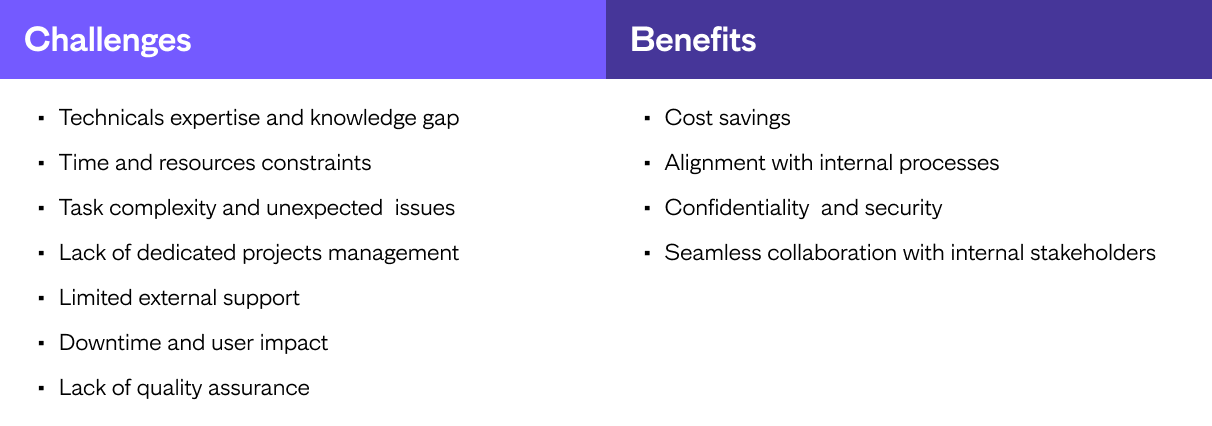Light
As one of the most powerful and flexible content management systems (CMS), Drupal empowers organizations to build and manage their websites and applications effectively. As the platform evolves and releases new versions, organizations must face the process of migrating or upgrading their existing Drupal implementations to stay up-to-date with the latest features and security enhancements.
As we approach the end of life (EOL) for Drupal 7 (D7) on January 5, 2025, it’s time for organizations to start planning their migration strategies. Upgrading a large or complex Drupal site is a major undertaking and demands significant time and resources. In this blog, we will explore the various approaches D7 users can use to tackle the challenge of migrating or upgrading to Drupal 10 (D10), while reviewing the pros and cons of each approach.
What does D7 EOL mean?
Drupal Founder Dries Buytaert recently announced D7 is scheduled to stop receiving further support on January 5, 2025. After this EOL date, D7 users will experience lessened community support as more sites upgrade from D7, leading to incremental support costs, no new features, limited resources and no security update patches, all adding to an outdated (and potentially vulnerable) website experience.
We’ve developed a few scenarios to illustrate how users can approach this coming evolution.
Scenario 1: Continue using D7
While continuing to use D7 for as long as possible may seem like an attractive option to many current D7 users, this scenario presents many significant challenges and pitfalls.
- Vulnerable website security: As D7 EOL approaches, security assistance and support will focus on D10, leaving a significant security gap for D7 users. This will pose serious risks of non-compliance with data security standards.
- Outdated editorial experience: D10 users benefit from a new default admin user interface (UI) — Claro — which provides a more modern UI experience compared to D7’s default theme, which doesn’t work well with modern JavaScript components.
- Incremental costs: As Drupal community and hosting partners slowly withdraw support for D7, finding external assistance will be complicated, expensive and require additional resources.
- API integration challenges: Drupal provides a secure API infrastructure that assists in building an integrated digital experience for end users. However, by continuing with D7, integration with third-party tools and systems will get more challenging as the platform evolves.
Given these conditions, the time to start planning your D7 migration is now. With D7 gradually losing support and becoming obsolete, it’s crucial to upgrade to improve the performance of your digital assets.
Scenario 2: An in-house D7 to D10 migration
Handling a Drupal migration in-house is an option for organizations with a capable and experienced IT team. However, while this approach may seem cost-effective at first, it can pose significant challenges, particularly for complex websites in terms of cost and time to complete the migration.
An in-house migration involves the following challenges and benefits:

Scenario 3: Migrate from D7 to D10 with a Drupal agency
Many organizations opt to collaborate with a specialized Drupal consulting company to manage their migration and upgrade needs. This approach leverages experts, potentially reducing the migration and upgrade risks, yet it can present its own set of challenges.
For example:

Scenario 4: Streamline your migration to D10 with Material’s Accelerators and Experts
To overcome the challenges faced in the previous scenarios, consider a more streamlined approach by leveraging Material’s Drupal expertise, which includes years of experience in handling Drupal migration and upgrade projects. With a streamlined process and accelerators, our experienced team can complete your D10 upgrade within the committed timeframe, allowing you to concentrate on your business while we manage all the aspects of Drupal migration.
Your business will additionally benefit from:
- Expert Drupal migration services: Our Drupal experts have successfully executed numerous migration projects and are well equipped to predict, analyze and mitigate any issues you may encounter during and after the migration process.
- Reduced downtime: Our experts can help you minimize downtime during the migration process, ensuring your website remains accessible to users throughout the transition.
- Module and theme evaluation: We will evaluate D7 modules and themes to determine their compatibility with D10, identify any deprecated modules and recommend suitable replacements.
- Testing and quality assurance: Rigorous testing of your D10 site will be conducted to ensure all functionalities work as expected, including extensive quality assurance checks, identifying and addressing any compatibility issues and removing any bugs or performance bottlenecks.
- Performance optimization: We will review your D10 website for optimization, including caching mechanisms, database configurations and server settings to ensure peak performance and scalability. By leveraging D10’s performance enhancements, our team will help maximize your site’s efficiency.
- Security enhancements: By updating security configurations, applying necessary patches and implementing best practices to protect your site from potential vulnerabilities, we will ensure your D10 site is secure and well protected.
- Documentation and training: We will provide comprehensive documentation of the migration process, including steps taken, customizations made and important considerations. This documentation serves as a valuable resource for future reference and troubleshooting. Additionally, we offer training sessions to ensure your team is familiar with D10’s interface and features.
The business benefits of a timely D10 migration are significant, thanks to the platform’s new features and improvements.
- Enhanced accessibility: D10 prioritizes accessibility compliance, making it easier for enterprises to create inclusive and accessible digital experiences. It provides improved support for accessibility standards and guidelines, ensuring that websites meet all necessary requirements.
- API-first approach: Using an API-first architecture enables organizations to leverage the power of headless or decoupled Drupal. This approach allows seamless integration with various front-end frameworks, mobile applications and IoT devices, providing flexibility in delivering content across multiple channels.
- Improved multilingual support: Enterprises operating in global markets often require multilingual capabilities. D10 offers enhanced multilingual support, including improvements in language handling, translation workflows and content translation management. This empowers enterprises to deliver localized experiences to their diverse user base.
- Advanced content authoring and workflow: D10 enhances content authoring and workflow capabilities, allowing enterprises to streamline their content creation and publishing processes. It offers an intuitive and user-friendly editing experience, advanced media management, revision control and customizable editorial workflows, enabling efficient content collaboration and governance.
- Robust security and compliance: D10 continues to prioritize security and compliance, providing enterprises with a secure foundation for their websites. It incorporates the latest security best practices, offers regular security updates and follows industry standards, making it a reliable choice for enterprises with stringent security and compliance requirements.
- Scalability and performance improvements: Enterprises often handle high traffic volumes and require a scalable and performant website to adjust to peak demand periods. D10 offers several performance improvements over D7, including faster page loading times, optimized caching mechanisms and scalability enhancements, ensuring smooth and responsive user experiences even under heavy loads.
- Improved configuration management: Managing complex configurations across multiple environments can be a challenge for enterprises. D10 simplifies configuration management with improvements to the configuration system. It also offers better import/export capabilities, configuration synchronization and staging workflows, allowing for more efficient deployment and management of any configuration changes.
- Enterprise-grade extensions and integrations: D10 provides robust extensibility options, enabling enterprises to integrate seamlessly with third-party systems, tools and services. It includes a wide range of contributed modules, APIs and integration capabilities, allowing enterprises to extend Drupal’s functionality and integrate with their existing technology stack.
These new features and improvements in D10 enable enterprises to build and manage robust, scalable and secure websites that meet specific business requirements. D10 provides enterprise IT teams with a future-proof platform that delivers exceptional digital experiences to customers while maintaining control, security and compliance.
Act Now: Start Your Drupal 7 to Drupal 10 Migration Today
It’s crucial to start planning your D7 to D10 migration now. Don’t wait until the last minute – start your migration journey today and ensure a smooth transition to D10.
Drupal migration and upgradation are critical to keep your website up-to-date and secure. Compared with the complexities, challenges and resource requirements of an in-house migration, collaborating with the right partner can reduce overall risks and provide expert guidance. Material’s migration services offer the best of both worlds: expertise, efficiency, reduced time consumption and strict compliance with the latest industry standards in the Drupal community.
Stay current and secure and deliver an exceptional digital experience to your users with the industry-leading Drupal development service.


